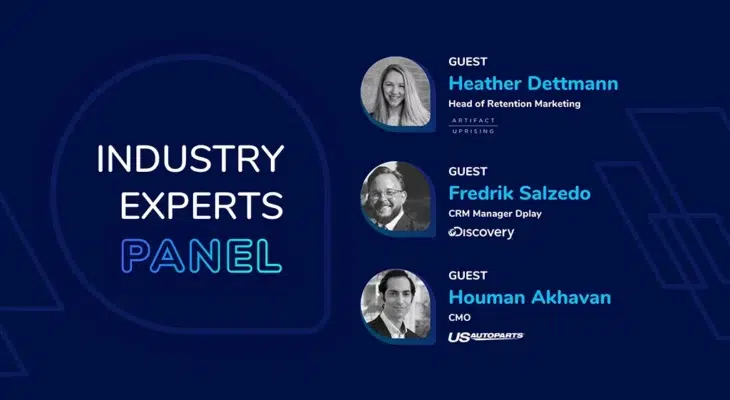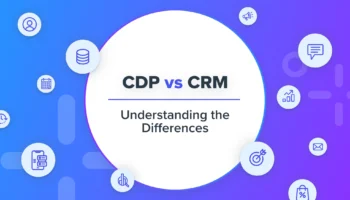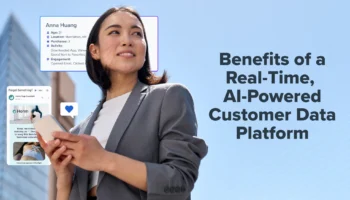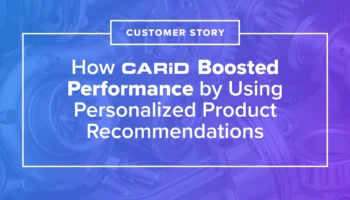Marketers, business leaders, and Blueshift users have come together for our first-ever virtual conference: Blueshift Engage. For one hour each day, we’ve brought the brightest minds in marketing to our attendees — live from their living rooms. We know marketers are busy folks, so we’ve taken our live sessions and picked out the best bits for your reading pleasure. For our second day, Blueshift’s Director of Customer Success, Mannie Frances, sat down with Houman Akhavan, CMO at US Auto Parts, Fredrik Salzedo, CRM Manager at Discovery Inc., and Heather Dettmann, Head of Retention Marketing at Artifact Uprising to discuss top strategies to connect the entire customer experience beyond single-channel silos and how to incite this change across your organization.
Blueshift Engage: The Importance of Connecting the Entire Customer Experience

MANNIE: WHEN WE TALK ABOUT CUSTOMER EXPERIENCE, WE OFTEN THINK ABOUT CHANNELS AND TRADITIONAL MARKETING COMMUNICATIONS. CAN YOU TALK ABOUT HOW THOSE CONCEPTS HAVE CHANGED AND HOW YOU CURRENTLY KEEP CUSTOMERS CONNECTED DURING THE ENTIRE CUSTOMER JOURNEY?
Fredrik: For Discovery, it’s really important because of course we are constantly putting out new content. We have to keep track of all of our content and know what is right, while still offering a personalized viewing experience — and the goal is to be as personalized as possible on every channel.
We don’t want to market you with shows that you may not like — let’s say I’m into Gold Rush and I get recommended something like Ex On The Beach — not a great fit. So for us, it’s been a challenge to be personalized across every channel, while remaining consistent and accurate.
Over in Europe, we have a quite young audience, which can be quite challenging because email is not always a great channel to communicate on. That’s where we use Blueshift to orchestrate all of those channels together and get as personalized as possible.
Heather: At Artifact Uprising, we really focus on the themes that Fredrik touched on. We want to meet customers where they are, we want to speak to them when they want to be spoken to, and we want to be hyper-relevant in what we’re bringing to the table so that we can keep them engaged and keep them coming back. And ultimately, help them discover new ways to interact and shop with our brand.
We love Blueshift because it helps us execute and orchestrate — I love that word. It really helps us do all of that at one time. We were able to use multichannel strategies and really segment based on customer preference and behavior.
Houman: If there are three words that I can suggest as a takeaway for today’s session, I would say, “First. Party. Data.” It’s really the foundation of most of our marketing and allows us to deliver a multichannel experience. First-party data is really where it starts. 20 years ago when email marketing started, you’d craft this perfectly curated email and it would go to 10 million people on your list — all with the exact same message. And there’s a lot of assumptions that go into that. At the end of the day, as a marketer, I don’t want to make the assumption that this one message is relevant to millions of people. First-party data has really solved that problem by allowing marketers to fine-tune their methodology.
For example, if I have a customer that drives a Chevy, I don’t want to irritate them by sending them an email about Ford parts. They love their Chevy, and that’s all they care about — that’s really what personalization is about, having a really deep understanding of the customer.
And, customers are giving you a vast amount of information just via their natural behavior. They click on search ads, they browse on social, and during all of this, they’re consuming content that you have made available. Being able to track all these inputs is really important you may have the best AI in the world, but if your data isn’t there, it’s “garbage in, garbage out.” I think the foundation is first-party data and that really drives everything that we do. And it’s going to be a longer-term roadmap — a lot of people get concerned about machine learning algorithms thinking it’s going to eliminate the job of a marketer. It’s actually the opposite — you leverage these algorithms to take over mundane tasks so you can focus on the creativity and the strategy that’s really necessary to be successful.
MANNIE: EITHER THIS WEEK ONE OF OUR SPEAKERS SAID, “DURING A CRISIS, DOORS ARE CLOSING AND NEW DOORS ARE OPENING. YOU WANT TO RUN THROUGH THOSE OPENING DOORS AS QUICKLY AS POSSIBLE.” CAN YOU SHARE AN INNOVATIVE CAMPAIGN YOU’VE LAUNCHED OR TESTED RECENTLY THAT REQUIRED RUNNING THROUGH “AN OPEN DOOR”?
Heather: We had a really unique opportunity in the last few weeks — it’s a big season for us, Mother’s day. People want to create meaningful gifts for mothers in their lives. Especially being a direct-to-consumer brand, we have the luxury of being able to bring things to people via mail and have them create gifts for people that they can touch.
We had a big win recently with Tik-Tok. An organic post went up from an influencer, that we weren’t working with, about how to make a mother’s day gif — featuring Artifact Uprising!
We saw incredible traction, a lot of traffic, a lot of purchasers, and an incredible amount of email and SMS growth from this post. If you’re not familiar with Tik-Tok yet, start getting familiar — it’s here. Their algorithm works so differently from other social networks, it allows content from users with much smaller followings to go viral, have people discover it, and share it.
One of the best ways I have heard it said, with reacting to a new opportunity like this, is, “Ready, shoot, aim.” You have to be able to react quickly when an opportunity presents itself. We worked very quickly to gain rights to that content so we could leverage it on other channels but also, we also took time to dissect that content and understand why it resonated with people, and talk about how we could replicate that.
Many professionals brush off Tik-Tok, thinking it’s just teens learning viral dances, but it’s not. We really looked deeper and tried to understand what we could do to leverage Tik-Tok as a direct-to-consumer brand.
Fredrik: In regards to COVID-19, because we are a streaming service we’ve seen some positives because people have to stay home — they’re going to need something to watch. But then on the other hand, we do own a lot of rights to sports broadcasts, and those are no longer happening.
So, we managed to round up famous athletes who find themselves with nothing to do and created the show Life on Hold. We also live broadcasted a training game with Zlatan. This situation has birthed new ways of doing things because, what do you do when you have no new sports matches, but you still have a sports broadcast business to run?
Houman: Anytime there’s an economic downturn, the companies that will emerge at the end of it are the ones that double down on what matters and what works — they are the ones that innovate. When a lot of this started happening, there were concerns and uncertainty, but the way I looked at it was, “where’s the opportunity for us?” What we’ve seen is there are many offline customers who never thought about purchasing online. So, we have a lot of first-time customers that are coming to the website or even just coming to the internet. This has accelerated digital transformation by 5 to 10 years, so being an online business is clearly a positive for us.
In addition to that, people view their vehicles as a form of therapy. They now suddenly have more time on their hands so they’ll spend it making repairs or fine-tuning their vehicles. Sales have been positive for us, Q1 was actually the biggest quarter in company history in our 25 years of existence. From a strategy standpoint, what worked before, is probably even more relevant now as more people are coming online. For us, content was important before. Now we’re developing more hyper-relevant content by understanding our data and trends.
But, at the end of the day, we are providing an essential service. It’s more than just sales. As marketers, we have a job to do, but we’re also providing a service that people really need in these difficult times. I told my team, find individuals that are in a really difficult place and see how we can help them out. If there’s a discount that they needed, we took care of them. If there’s anything that you can do to help, definitely do it.
We had a number of our employees acquire 3D printing equipment and printed face shields for healthcare workers. It was unfunded at the beginning, they did it out of their own pockets. And then as US Auto Parts learned about it, we invested in the effort and were able to produce 403 printed, face shield masks, and donated them to local hospitals.
MANNIE: WHAT ARE SOME OF YOUR MAJOR CX INITIATIVES FOR 2020 AND HOW HAVE YOUR PLANS CHANGED SINCE THE EMERGENCE OF COVID-19?
Fredrik: The plan is to scale up even more. We are active in around 10+ countries in Europe and we have activity in Japan. We have quite a few countries lined up to launch D-Play in, but it’s quite easy for us because Discovery, Inc. is a globally recognized brand.
Our goal is to continue to scale up in CRM and marketing automation. We have a major competitor, Netflix which offers a top-of-the-line experience. To help us succeed we’re relying on Blueshift to fully own all our orchestration and recommendations. This will help us deliver those Netflix-level recommendations and set the bar high for customer expectations.
Heather: From a CX perspective, we’re focused on going deeper. We’ve talked about personalization and how reliant that personalization is on behavioral cues. And for us, our shopping experience is a little different from traditional eCommerce because it’s a product that you have to spend time with, that you have to build prior to that purchase moment.
We have tiny points within the customer journey that we haven’t been able to mine for data and we’re really excited to get down to that level to have more insight on what people are creating. We’re always working to improve our editor experience and our personalization capabilities, but we’re really excited about the data that we’re going to be able to leverage from those little touchpoints.
We’re a small business, a startup if you will. We’re about seven years in, but we’re really looking to expand. We’re overhauling our referral program, we’re dipping our toes into some loyalty initiatives and things that haven’t been present. We’ve had a lot of success with SMS, and then as we mentioned, social is an important part of our entire marketing ecosystem.
We leverage a ton of UGC content, especially in email. And we’re bringing content down to that personalized level too. I love what was said earlier, that content, and the importance of content relevancy. We’re learning more about what people interact with from a content perspective and when they come in through different types of content, what type of customer they’re probably going to be down the line, and leveraging information to help them.
Houman: We’re really thinking about the holistic marketing experience. A customer might come to us through search, or email, or social, and leveraging our first-party data to really drive each of those channels and to ensure that there’s a consistent messaging experience.
Again, it goes back to first-party data. That’s the foundation. We need to make sure that we’re collecting the right pieces of information. How do you do that at scale? That’s where our partnership with Blueshift has come in. We’ve made some great progress over the last 12 months and we’re really looking forward to the future and all the additional possibilities, as we continue to leverage the data that we’ve amassed today.
MANNIE: HOW HAVE YOU WORKED WITHIN YOUR ORGANIZATION TO COMMUNICATE YOUR VISION TO BE ABLE TO RALLY THE TROOPS AROUND THIS INVESTMENT?
Fredrik: Honestly, it wasn’t hard because we came in with top-of-the-line solutions like Blueshift. I’m not a marketer, my team is a technical team — our role was to build out the technical parts of our marketing, like recommendations. A few years ago we were not tracking anything. We had the status of your subscription, your name, and maybe your country — good luck on creating recommendations. When we found Blueshift and it was ready to be deployed, every marketing team welcomed us with open arms because it was such a big change and the solution to all of their problems.
AUDIENCE QUESTION: YOU ARE ALL DOING FAIRLY ADVANCED MARKETING ACROSS MULTIPLE CHANNELS USING CUSTOMER DATA, HOW BIG OF A TEAM DO YOU NEED TO PULL THIS OFF?
Heather: Bigger than we have now. That’s always the answer. We are a small team. We move fast and break things. There are two of us on the CRM team and we are supported by a revenue team that is about five people strong. We do not have a dedicated data analyst as we have had in the past. So, all of our team members are scrappy and have knowledge in this area, and we leverage the platform Looker.
It’s part of our culture. I think that testing and learning is extremely important. If we’re gonna fail, we’re going to fail fast because we don’t have that big budget here. And so, we need to be very cognizant of where we’re dedicating our time and our budget. And so for cross channel activities, is really a team effort. I’m lucky to have one of the most talented teams I’ve ever worked with, everyone’s a rockstar and we do a lot with a little.
Fredrik: I work with a team of 6 people, most are marketing automation specialists. We build workflows in Blueshift and test how we can automate as much as possible. Even if the goal is to reach 100% automation, it’s impossible to reach that. We will never totally as we have ad-hoc campaigns for new shows or new seasons.
We coordinate with each country to see what’s coming up and then build out the automated workflows. But again, we’re tech people not marketers. So my team will build the one-off campaigns with the frameworks that the local marketing teams give us. But, as Heather says, if I could, I would hire many more people.
Houman: We’re about a team of five which is lean, but I think Heather made the comment that more is not necessarily better. We have a variety in terms of experiences within the team. Somebody strong in analytics, somebody strong in creative, somebody strong in copywriting, and bringing all these different experiences together all of them play a specific purpose.
Like both Heather and Frederick, I absolutely love my team. At the end of the day, it’s easy here to talk on this panel and talk about the successes, but it really comes down to the people on the team. Day in, day out, they put their head down and really want to create something that’s memorable and something that’s helpful and useful.
FINAL THOUGHTS
Houman said it best, “If you take anything away today it should be this: use first-party data and be relevant.” Short and sweet, but oh-so-true! Today’s panel has been incredibly inspiring, seeing how many marketers are doing good for the customer and the world in these difficult times. It’s reassuring to know that we’re all tackling the same issues and if we work together we will find the answers we need.


